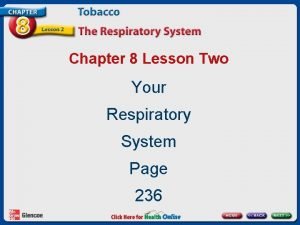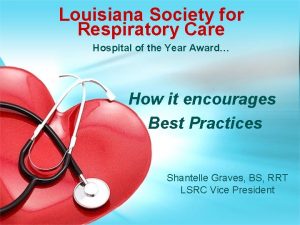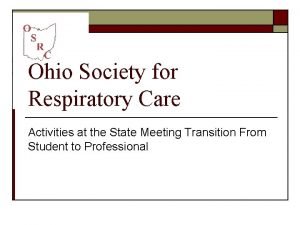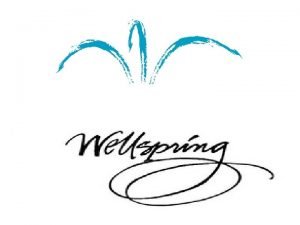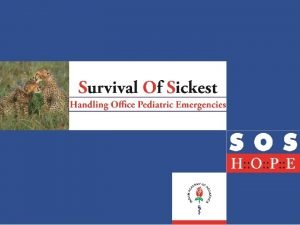Respiratory Care Who What Where When Mission Statement











- Slides: 11

Respiratory Care Who, What, Where, When?

Mission Statement • The American Association for Respiratory Care (AARC) will continue to be the leading national and international professional association for respiratory care. The AARC will encourage and promote professional excellence, advance the science and practice of respiratory care, and serve as an advocate for patients, their families, the public, the profession and the respiratory therapist.

Timeline • 1943: Edward R. Levine, MD, establishes a primitive inhalation therapy program using on-the-job trained technicians to manage postsurgical patients at Michael Reese Hospital in Chicago. • July 13, 1946: Dr. Levine’s students and other interested doctors, nurses, and oxygen orderlies meet at the University of Chicago Hospital to form the Inhalation Therapy Association (ITA).

• March 16, 1954: The ITA is renamed the American Association of Inhalation Therapists (AAIT). • 1956: The AAIT begins publishing a science journal, Inhalation Therapy (now RESPIRATORY CARE) • October 1957: The AAIT, AMA, American College of Chest Physicians, and American Society of Anesthesiologists jointly adopt the Essentials for an Approved School of Inhalation Therapy Technicians; the Essentials begin a three year trial period. • 1960: The American Registry of Inhalation Therapists (ARIT) is formed to oversee a new examination leading to a formal credential for people in the field. • November 18, 1960: The ARIT administers the first Registry exams in Minneapolis.

• October 8, 1963: The Board of Schools of Inhalation Therapy Technicians is formed in Chicago. • 1969: The AAIT launches the Technician Certification Program to offer a credential to people working in the field who do not qualify to take the Registry exams. • January 9, 1970: The Board of Schools of Inhalation Therapy Technicians becomes the Joint Review Committee for Respiratory Therapy Education (JRCRTE). • 1973: The AAIT becomes the American Association for Respiratory Therapy (AART).

• 1974: The profession’s two credentialing programs merge into the National Board for Respiratory Therapy (NBRT); the AAIT forms the American Respiratory Therapy Foundation (ARTF) to support research, education, and charitable activities in the profession. • 1982: California passes the first modern licensure law governing the profession of respiratory care; President Ronald Reagan proclaims the first National Respiratory Care Week.

• 1986: The AART becomes the American Association for Respiratory Care (AARC); the ARTF becomes the American Respiratory Care Foundation (ARCF); the NBRT becomes the National Board for Respiratory Care (NBRC).

• 1998: The JRCRTE evolves into the Committee on Accreditation for Respiratory Care (Co. ARC). • 2004: Vermont becomes the 48 th state to pass a licensure or other legal credentialing law governing the profession of respiratory care, effectively bringing legal credentialing to all 48 contiguous states. • The AARC’s 52 nd International Respiratory Congress is scheduled for December 4– 7 in Las Vegas, Nevada. • The future? Hawaii and licensure?

• AARC, the national organization • 50 state societies (charter affiliates) and Puerto Rico • Sponsoring Organizations – The AARC is sponsored by the American Thoracic Society, the American College of Chest Physicians, and the American Society of Anesthesiologists.

• The National Board for Respiratory Care, the body that administers nationally recognized credentialing examinations for respiratory therapists and other allied health practitioners. • Advocacy – The AARC interacts with local, state, and federal government on public policies that affect our patients and our members. From Tobacco Settlement monies, to Medicare and Medicaid reimbursement issues, to health -care reform proposals, the AARC keeps Congress, state, and local policymakers up-to-date on the issues that are important to patient care and respiratory practice.

• More than 30 years of the profession in Hawaii • Small group of LPNs at Kuakini were initially recruited to become “inhalation therapists” • >300 practicing therapists at hospitals, physician offices, and in home care. • Annual education conference
 Conducting zone and respiratory zone
Conducting zone and respiratory zone Health care levels primary secondary tertiary
Health care levels primary secondary tertiary Taking care of your respiratory system
Taking care of your respiratory system Respiratory care louisiana
Respiratory care louisiana Ohio society for respiratory care
Ohio society for respiratory care Zumiez mission statement
Zumiez mission statement Xerox mission
Xerox mission Dogs trust mission
Dogs trust mission Aveda my passion
Aveda my passion Lenovo swot
Lenovo swot Recruitment vision statement
Recruitment vision statement Ahg oath song
Ahg oath song


